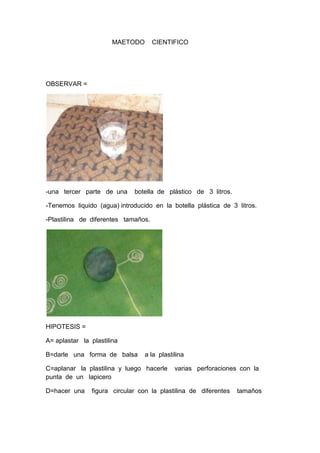Maetodo cientifico
•Télécharger en tant que DOCX, PDF•
1 j'aime•2,199 vues
Signaler
Partager
Signaler
Partager

Recommandé
Recommandé
Contenu connexe
En vedette
En vedette (20)
Product Design Trends in 2024 | Teenage Engineerings

Product Design Trends in 2024 | Teenage Engineerings
How Race, Age and Gender Shape Attitudes Towards Mental Health

How Race, Age and Gender Shape Attitudes Towards Mental Health
AI Trends in Creative Operations 2024 by Artwork Flow.pdf

AI Trends in Creative Operations 2024 by Artwork Flow.pdf
Content Methodology: A Best Practices Report (Webinar)

Content Methodology: A Best Practices Report (Webinar)
How to Prepare For a Successful Job Search for 2024

How to Prepare For a Successful Job Search for 2024
Social Media Marketing Trends 2024 // The Global Indie Insights

Social Media Marketing Trends 2024 // The Global Indie Insights
Trends In Paid Search: Navigating The Digital Landscape In 2024

Trends In Paid Search: Navigating The Digital Landscape In 2024
5 Public speaking tips from TED - Visualized summary

5 Public speaking tips from TED - Visualized summary
Google's Just Not That Into You: Understanding Core Updates & Search Intent

Google's Just Not That Into You: Understanding Core Updates & Search Intent
The six step guide to practical project management

The six step guide to practical project management
Beginners Guide to TikTok for Search - Rachel Pearson - We are Tilt __ Bright...

Beginners Guide to TikTok for Search - Rachel Pearson - We are Tilt __ Bright...
Maetodo cientifico
- 1. MAETODO CIENTIFICO <br />OBSERVAR =<br />-una tercer parte de una botella de plástico de 3 litros.<br />-Tenemos liquido (agua) introducido en la botella plástica de 3 litros.<br />-Plastilina de diferentes tamaños.<br />HIPOTESIS =<br />A= aplastar la plastilina<br />B=darle una forma de balsa a la plastilina <br />C=aplanar la plastilina y luego hacerle varias perforaciones con la punta de un lapicero <br />D=hacer una figura circular con la plastilina de diferentes tamaños <br />E=hacer una figura circular con la plastilina , pero con una perforación en la mitad <br />F=hacer una figura con la plastilina y luego tratar de introducirle aire con la boca y sellarla bien <br />ANALIZIS =<br />A-B = Creemos que estas dos hipótesis nos servirán ya que al aplanar la plastilina la hará mas liviana y podrá flotar <br />C-E =Creemos en estas dos hipótesis en una 50% ya que se tratan de hacer varias perforaciones a la plastilina para observar si flotara<br />D-F =Tenemos más confianza en estas dos hipótesis ya que a simple vista creemos que son las que mejor resultados nos dará para sacar el experimento adelante <br />EXPERIMENTACION =<br />1 Colocamos la plastilina suavemente en el agua flotaba pero al mover la botella se sumergía<br /> <br />2 Colocamos la plastilina suavemente en el agua flotaba pero al mover la botella también se sumergía <br /> <br />3 Colocamos la plastilina suavemente en el agua pero con las perforaciones se sumergía rápidamente<br />4 Colocamos una bola de plastilina suavemente y se sumergía rápidamente (no importaba la altura en que se lanzara siempre se sumergía)<br />5 En esta también hicimos el mismo procedimiento pero en la bola de plastilina le hicimos una perforación en el centro pero también se sumergió<br />6 En esta que es la ultima trataba de hacer cualquier figura con la plastilina y introducirle aire cen la boca y efectivamente esta fue la que nos sirvio ya q al introducirle el aire la convertia como en una especie de flotador .<br />SOLUCION =<br />Fue la última hipótesis (6) ya que se dice que todo lo que tiene aire siempre flotara y probamos esto con la plastilina y nos dio resultado hacia el objetivo .<br />